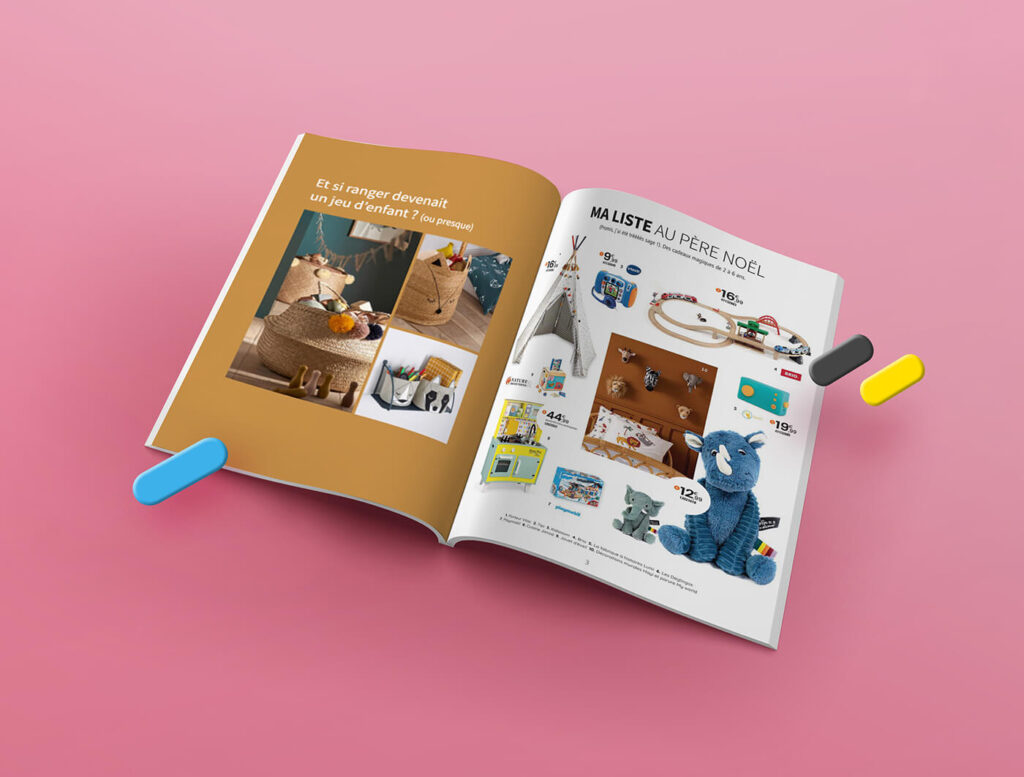Print production
Catalogues, brochures, magazines, etc..
No in-house graphic designers? Peak activity?
Our graphic designers are here to produce, or help you produce, your publications.
In order to offer a solution that meets the needs of graphic designers and print production, we produce the catalogues of some of our customers. This enables us to ensure that the tools and processes we put in place are functional and meet the needs of end users.
From the graphic charter to the print PDF, we have ‘Créa’ or ‘Exe’ profiles to meet your needs and automate the production chain as far as possible.

A production manager leads the teams and ensures that requests are taken on board, understood and carried out, so that you have just one contact.
Our platform centralises data by retrieving products and media from your PIM or other sources.
Once the product data is available, the print brief can be created to visualise your catalogue, with a graphic rendering very close to the final result, without the need for graphic designers to intervene.
The production workflow allows you to associate states with the pages so that our graphic designers are notified and automatically generate the pages in Adobe InDesign.
After adjustment, the pages are exported as PDFs and uploaded to the platform so that you, in turn, can be notified. A proofing tool allows you to make annotations, requests for corrections, etc., which are sent to our teams.
Once the corrections have been made, a new version of the PDF is uploaded to the platform. This allows you to compare the 2 latest versions. A graphical highlight allows you to quickly see the changes that have been made and ensure that your requests have been taken into account.
At the end of production, we provide you with the following files:
– HD Print PDF (CMYK, markers, 100% black, etc.)
– Low-resolution PDF (version without marks and RGB)
– The flipbook of your catalogue (viewable on and off-line)
– InDesign assemblies
Our teams are fully conversant with the automation, solution and advanced features of Adobe InDesign, enabling us to offer really attractive costs per page.
- Reduced lead times and costs
- Improved responsiveness
- Minimised risk of errors
- Multilingual versions
- & virtually instantaneous corrections
- No graphic restrictions
- Easy to use
- Control of the graphic charter
- Data enhancement over time
- Real-time data updates
- 100% automated publications possible
- (No manual intervention required)
- Automated indexes and tables of contents
- Variations of publications (members, agencies, etc.)
Of course, we also produce brochures and catalogues
and catalogues in the traditional way.
If only at the beginning, or at the end, of catalogues, there are often so-called ‘institutional’ pages that are produced manually because they contain no product data.
Our teams also take care of these pages, with the assurance that they will be produced in an optimal way, using InDesign libraries, paragraph styles, characters, tables, objects, etc… so that they can be modified or developed easily and quickly.
If required, we will take care of the relationship with the printer so that we can talk directly to them and deliver the files where and how they want them (plates, books, pages, etc.).

Discover our different productions


